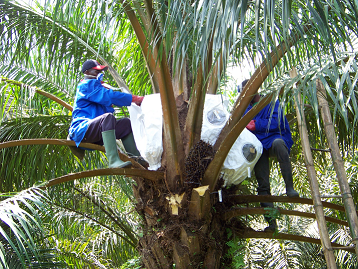Research and Development

OVERVIEW
A scientific and comprehensive oil palm research and breeding programme began in Lobe in 1948 for selection to improve yield and testing for wilt resistance initiated by Unilever plc, an Anglo-Saxon group
This programme is now in the third generation of selection with genetic materials introduced from various origins in the world comprising:
NIFOR-Nigeria (Aba, Ufuma, Calabar), Deli (Malaysia) La Me (Cote d’ Ivoire), Pobe (Benin), INEAC, Yaligimba (DRC-former Zaire). Dami (Papua New Guinea), Ecuador, Angola and Bamenda, Ekona (Cameroon). These various origins confer to the Pamol planting material a broad genetic base for wide adaptation in different agro ecologies.
This collection provides what is genetically one of the most varied and broadly based collections of Oil Palm Breeding materials presently in Africa.
The breeding programme resulted in the selection of 487 elite dura palms and 10 pisifera palms which are currently used for seed production. The potential production is about 2,922,000 seeds per year.
This programme is now in the third generation of selection with genetic materials introduced from various origins in the world comprising:
NIFOR-Nigeria (Aba, Ufuma, Calabar), Deli (Malaysia) La Me (Cote d’ Ivoire), Pobe (Benin), INEAC, Yaligimba (DRC-former Zaire). Dami (Papua New Guinea), Ecuador, Angola and Bamenda, Ekona (Cameroon). These various origins confer to the Pamol planting material a broad genetic base for wide adaptation in different agro ecologies.
This collection provides what is genetically one of the most varied and broadly based collections of Oil Palm Breeding materials presently in Africa.
The breeding programme resulted in the selection of 487 elite dura palms and 10 pisifera palms which are currently used for seed production. The potential production is about 2,922,000 seeds per year.
LOBE SEED PRODUCTION POTENTIAL
There is presently a production potential of 2,922,000 seeds comprising of 1,230,000 standard seeds, 1,590,000 wilt resistant seeds and 102,000 highland (BD x P) seeds. Figure 1 shows the actual seed production from 2008 to 2017. Actual production for 2017 is 901,039 standard seeds, 339,946 wilt resistant seeds and 42,974 highland (BDxP) seeds giving a total of 1,283,959 seeds.
ADVANCEMENTS
For advancement of the seed production programme, the next cycle of selection, leading to the creation of new progenies with about 30% higher yields than materials presently in use today must be undertaken. It is recommended that we migrate from the modified recurrent selection scheme presently in use to the Reciprocal Recurrent Selection Scheme. This will also require renovating and updating procedures in the Bunch Analysis laboratory. This is necessary for measurement of bunch quality parameters of the progenies that will be evaluated in the new research trials from three to ten years after planting.
LOBE BREEDING PROGRAMME

CONTROLLED POLLINATION

POLLEN VIABILITY TEST

SEED SORTING



